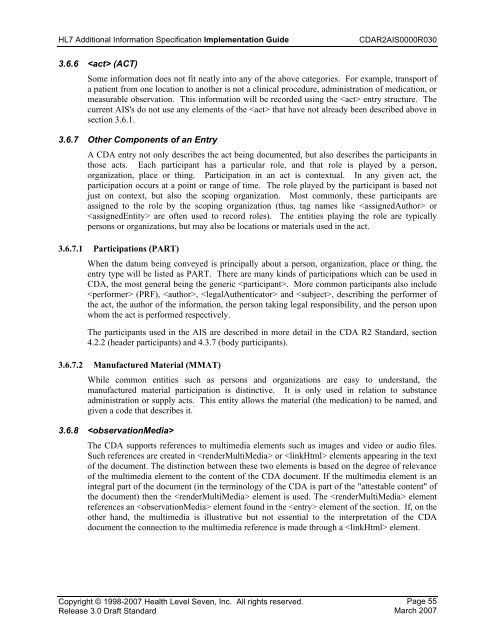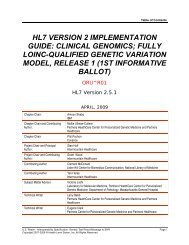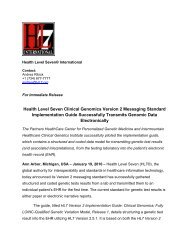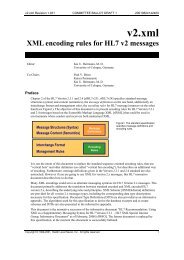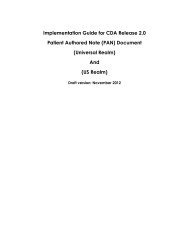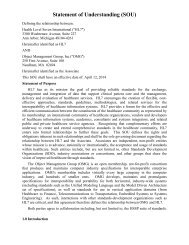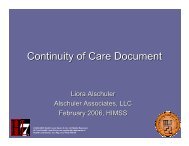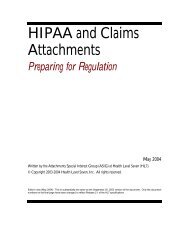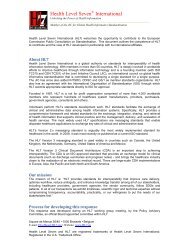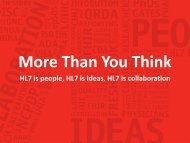HL7 CDA R2 AIS Implementation Guide
HL7 CDA R2 AIS Implementation Guide
HL7 CDA R2 AIS Implementation Guide
Create successful ePaper yourself
Turn your PDF publications into a flip-book with our unique Google optimized e-Paper software.
<strong>HL7</strong> Additional Information Specification <strong>Implementation</strong> <strong>Guide</strong><strong>CDA</strong><strong>R2</strong><strong>AIS</strong>0000R0303.6.6 (ACT)Some information does not fit neatly into any of the above categories. For example, transport ofa patient from one location to another is not a clinical procedure, administration of medication, ormeasurable observation. This information will be recorded using the entry structure. Thecurrent <strong>AIS</strong>'s do not use any elements of the that have not already been described above insection 3.6.1.3.6.7 Other Components of an EntryA <strong>CDA</strong> entry not only describes the act being documented, but also describes the participants inthose acts. Each participant has a particular role, and that role is played by a person,organization, place or thing. Participation in an act is contextual. In any given act, theparticipation occurs at a point or range of time. The role played by the participant is based notjust on context, but also the scoping organization. Most commonly, these participants areassigned to the role by the scoping organization (thus, tag names like or are often used to record roles). The entities playing the role are typicallypersons or organizations, but may also be locations or materials used in the act.3.6.7.1 Participations (PART)When the datum being conveyed is principally about a person, organization, place or thing, theentry type will be listed as PART. There are many kinds of participations which can be used in<strong>CDA</strong>, the most general being the generic . More common participants also include (PRF), , and , describing the performer ofthe act, the author of the information, the person taking legal responsibility, and the person uponwhom the act is performed respectively.The participants used in the <strong>AIS</strong> are described in more detail in the <strong>CDA</strong> <strong>R2</strong> Standard, section4.2.2 (header participants) and 4.3.7 (body participants).3.6.7.2 Manufactured Material (MMAT)While common entities such as persons and organizations are easy to understand, themanufactured material participation is distinctive. It is only used in relation to substanceadministration or supply acts. This entity allows the material (the medication) to be named, andgiven a code that describes it.3.6.8 The <strong>CDA</strong> supports references to multimedia elements such as images and video or audio files.Such references are created in or elements appearing in the textof the document. The distinction between these two elements is based on the degree of relevanceof the multimedia element to the content of the <strong>CDA</strong> document. If the multimedia element is anintegral part of the document (in the terminology of the <strong>CDA</strong> is part of the "attestable content" ofthe document) then the element is used. The elementreferences an element found in the element of the section. If, on theother hand, the multimedia is illustrative but not essential to the interpretation of the <strong>CDA</strong>document the connection to the multimedia reference is made through a element.Copyright © 1998-2007 Health Level Seven, Inc. All rights reserved.Release 3.0 Draft StandardPage 55March 2007


